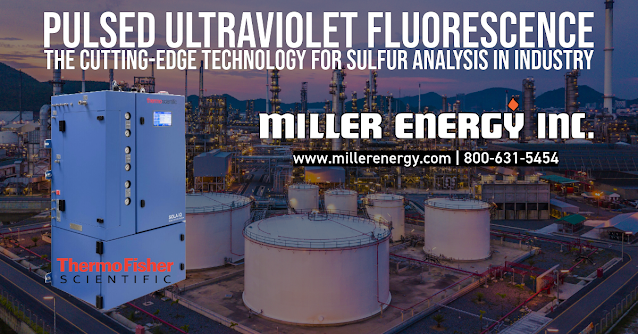A blog specializing in pressure, temperature, level and flow instrumentation, control valves, process analyzers, and all other areas of process measurement. Courtesy of Miller Energy, a New Jersey, New York, Pennsylvania, and Ohio process instrumentation Rep and Distributor.
Happy Holidays from Miller Energy
AquaPro™ Multi-Input Intelligent Process Transmitters
Miller Energy, Inc.
Phone: 800-631-5454
In Eastern Pennsylvania and Delaware:
Phone: 610-363-6200
In Western Pennsylvania:
Phone: 412-257-0200
In Ohio:
Phone: 440-735-0100
The Indispensable Role of Process Control Sales Engineers in the Digital Age
Miller Energy, Inc.
800-631-5454
https://millerenergy.com
Advanced Valve Automation Solutions
- Automated Ball Valves
- Automated Butterfly Valves
- Automated Control Valves
- Automated Knife Gate Valves
- Pneumatic, Electric, and Hydraulic Actuators
- Accessories like positioners, solenoid valves, and limit switches
Miller Energy, Inc.
https://millerenergy.com
800-631-5454
Enhancing Industrial Safety: The Dual Protection of the Cashco Model 6K00
The Role of Pressure/Vacuum Vents in Industrial Safety
Integrated Flame Arrestors: A Critical Safety Feature
800-631-5454
https://millerenergy.com
The Schubert & Salzer Three-Way Ball Sector Valve 4080
Quantim® QMC Coriolis Mass Flow Meters & Controllers
800-631-5454
https://millerenergy.com
Pulsed Ultraviolet Fluorescence: The Cutting-edge Technology for Sulfur Analysis in Industry
Pulsed Ultraviolet Fluorescence (PUVF) is an analytical technique with a wide range of applications. It is used to measure the concentration of sulfur compounds in various matrices, such as liquid fuels, gases, and process streams. This versatile technology is widely used in industrial applications and in online sulfur analyzers, demonstrating its adaptability to different industries and settings.
Here's how PUVF works:
- Sample introduction: The sample (liquid or gas) is introduced into the analyzer's combustion chamber.
- Combustion: The sample is completely oxidized in the combustion chamber at high temperatures, converting all sulfur compounds into sulfur dioxide (SO2).
- Excitation: The SO2 molecules are exposed to pulsed ultraviolet light, typically from a xenon flashlamp. This UV light excites the SO2 molecules to a higher energy state.
- Fluorescence: As the excited SO2 molecules return to their ground state, they emit light (fluorescence) at a specific wavelength.
- Detection: The fluorescence intensity is measured using a photomultiplier tube (PMT) or other suitable detector. The fluorescence intensity is directly proportional to the concentration of SO2 in the sample.
- Calculation: The analyzer's software calculates the total sulfur concentration in the original sample based on the measured SO2 concentration and the sample's properties (e.g., density, flow rate).
PUVF technology offers several advantages over other sulfur measurement techniques:
- High sensitivity: PUVF can detect sulfur concentrations in the parts-per-billion (ppb) range.
- Selectivity: The specific wavelength of SO2 fluorescence minimizes interference from other compounds.
- Linearity: The fluorescence intensity has a linear relationship with the sulfur concentration over a wide range.
- Rapid response: PUVF analyzers provide real-time measurements, enabling quick process control and optimization.
PUVF technology is widely used for online sulfur monitoring and control in many industries including:
- Petroleum refining: Monitoring sulfur content in crude oil, refined products (gasoline, diesel, kerosene), and process streams is crucial for meeting environmental regulations and product specifications.
- Natural gas processing: Measuring sulfur compounds (H2S, mercaptans) in natural gas ensures gas quality and prevents corrosion in pipelines and equipment.
- Chemical manufacturing: Monitoring sulfur content is important in various chemical processes, such as the production of sulfuric acid, fertilizers, and other sulfur-containing compounds.
- Environmental monitoring: To comply with air quality regulations, sulfur dioxide (SO2) emissions from industrial sources, such as power plants and factories, must be measured.
- Biogas and landfill gas: Monitoring sulfur compounds (H2S) in biogas and landfill gas is essential for ensuring the safety and efficiency of gas utilization systems, such as engines and fuel cells.
- Metallurgical processes: The sulfur content in metals and ores controls the quality of the final product and optimizes the smelting process.
- Food and beverage industry: Measuring sulfur dioxide in wine, dried fruits, and other food products is necessary for quality control and compliance with food safety regulations.
- Automotive industry: Monitoring sulfur content in fuels and lubricants is crucial for maintaining the performance and longevity of engines and emission control systems.
800-631-5454
https://millerenergy.com
The Future of Industrial Valve Automation: Innovations and Trends for the Next Five Years
Enhanced Predictive Maintenance Capabilities
Integration of Artificial Intelligence and Machine Learning
Development of Smart Valves
Advancements in Safety and Security
Greater Compatibility and Standardization
Conclusion
800-631-5454
https://millerenergy.com
From Raw Materials to Finished Products: Ensuring Quality with Industrial Process Refractometers in the Chemical Industry
- Indispensable tools in the chemical processing industry.
- Offering a multifaceted approach to ensuring product quality.
- Enhancing process safety.
- Improving efficiency.
Miller Energy, Inc.
https://millerenergy.com
800-631-5454









